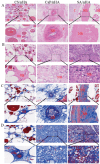Comparison of different hydroxyapatite composites for bone tissue repair: In vitro and in vivo analyses
- PMID: 39055877
- PMCID: PMC11266744
- DOI: 10.22038/IJBMS.2024.78578.16995
Comparison of different hydroxyapatite composites for bone tissue repair: In vitro and in vivo analyses
Abstract
Objectives: The material used for bone tissue repair needs to be simultaneously osteoconductive, osteoinductive, and osteogenic. To overcome this problem, researchers combine hydroxyapatite (HA) with natural materials to improve properties. This paper compares the effects of angiogenesis and osteogenesis with different composites through in vivo experiments and characterization analysis.
Materials and methods: Chitosan/nHA (CS/nHA) and sodium alginate/nHA (SA/nHA) microspheres were synthesized via reverse-phase emulsification crosslinking and analyzed using scanning electron microscopy (SEM), energy dispersion spectroscopy (EDS), and X-ray diffraction (XRD). Implanted into mouse thigh muscles, their angiogenic and osteogenic potentials were assessed after 8 and 12 weeks through various staining methods and immunohistochemistry.
Results: The mean vascular density (MVD) of CS/nHA, CaP/nHA, and SA/nHA groups was (134.92±35.30) n/mm2, (159.09±22.14) n/mm2, (160.31±42.23) n/mm2 at 12 weeks, respectively. The MVD of the CaP/nHA and SA/nHA groups were significantly higher than that of the CS/nHA group. The collagen volume fractions (CVF) were 34.13%, 51.53%, and 54.96% in the CS/nHA, CaP/nHA, and SA/nHA groups, respectively. In addition, the positive expression area ratios of OPN and CD31 in the CaP/nHA and SA/nHA groups were also significantly higher than those in the CS/nHA group.
Conclusion: The ability of SA/nHA composite microspheres in osteogenesis and angiogenesis is clearly superior to that of the CS/nHA group and is comparable to that of CaP/nHA, which has superior osteogenesis ability, indicating that SA/nHA composite microspheres have greater application prospects in bone tissue engineering.
Keywords: Angiogenesis; Chitosan; Hydroxyapatite; Osteoinduction; Sodium alginate.
Conflict of interest statement
The authors declare no conflicts of interest.
Figures





Similar articles
-
Magnesium-Doped Nano-Hydroxyapatite/Polyvinyl Alcohol/Chitosan Composite Hydrogel: Preparation and Characterization.Int J Nanomedicine. 2024 Jan 20;19:651-671. doi: 10.2147/IJN.S434060. eCollection 2024. Int J Nanomedicine. 2024. PMID: 38269254 Free PMC article.
-
Ectopic osteogenesis and scaffold biodegradation of nano-hydroxyapatite-chitosan in a rat model.PLoS One. 2015 Aug 10;10(8):e0135366. doi: 10.1371/journal.pone.0135366. eCollection 2015. PLoS One. 2015. PMID: 26258851 Free PMC article.
-
Fabrication and characterization of hydroxyapatite/sodium alginate/chitosan composite microspheres for drug delivery and bone tissue engineering.Mater Sci Eng C Mater Biol Appl. 2019 Jul;100:576-583. doi: 10.1016/j.msec.2019.03.040. Epub 2019 Mar 11. Mater Sci Eng C Mater Biol Appl. 2019. PMID: 30948094
-
A Naringin-loaded gelatin-microsphere/nano-hydroxyapatite/silk fibroin composite scaffold promoted healing of critical-size vertebral defects in ovariectomised rat.Int J Biol Macromol. 2021 Dec 15;193(Pt A):510-518. doi: 10.1016/j.ijbiomac.2021.10.036. Epub 2021 Oct 25. Int J Biol Macromol. 2021. PMID: 34710477
-
Graphene Oxide-A Tool for the Preparation of Chemically Crosslinking Free Alginate-Chitosan-Collagen Scaffolds for Bone Tissue Engineering.ACS Appl Mater Interfaces. 2018 Apr 18;10(15):12441-12452. doi: 10.1021/acsami.8b00699. Epub 2018 Apr 9. ACS Appl Mater Interfaces. 2018. PMID: 29589895
References
LinkOut - more resources
Full Text Sources
Research Materials
Miscellaneous
